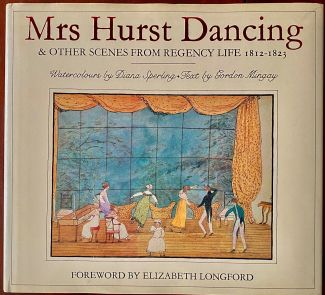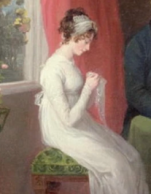After much celebration, Christmas and New Year’s festivities are over. I dare not weigh myself until I’ve dieted for a week. Wine and spirits are banned for the time being. Decorations will eventually be stashed away as life slowly returns to normal.
We still celebrate these holidays in similar ways to those held in the past. Lesley-Anne McCleod wrote about the similarity of Christmas and New Year’s celebrations in a 2016 post entitled A Regency New Year–“Begin as you mean to go on:
“New Year’s Eve and New Year’s Day in the Regency era in England was celebrated, it seems, very much like Christmas with: Parties and celebrations … particularly among the Royals … gifts … and acts of charity…”

Book Cover of Mrs Hurst Dancing
Dancing:
Today as in Austen’s time we still party and dance the night away. In the book cover image above, Diana Sperling painted a private dance party at home, with the rug rolled up and the furniture pulled aside. One of the ladies plays the pianoforte for the dancers. Some – an older woman/chaperone (?), a young girl wearing a cap, and a young woman without a cap – sit on the sidelines.

Pappy and Mum play chess
While the younger crowd danced exuberantly, one imagines that their elders enjoyed a quieter way to spend the time – near a fire, perhaps, while playing a game, much like Mr Woodhouse and Emma or Mr Knightley might have done.
Dining and Feasting:

Dynes Hall, Family at Dinner
Dinners with guests and family would be intimate, as in this image (see the bird cage at right?), or enormous, as with the Royals and the very wealthy, like Mr Bingley and Mr Darcy.
Please Note: images might be copyrighted. If enlarged, these will lose clarity.
Transportation:

Returning from a dinner party at night, 1816
Visiting neighbors or friends in nearby villages at night presented logistics. Roads were unlit and often deeply rutted and muddy after heavy rains or melting snow. The preferred days for traveling coincided with the full moon, which at times was obscured by clouds. Lanterns helped to pave the way, yet the going was still rough, as this Sperling image shows.
The threat of snow was enough to put a spoke in plans. In Austen’s Emma, Mr Woodhouse, having been enticed from his cozy chair in front of his fire to attend the Westons’ dinner, hastened before food service hardly began to hie it back home before the snow accumulated.
Charity:

Detail, Group portrait at a drawing room table, Maria Spilsbury
Charity played an important part in Regency England. Ladies from the middle classes and upward gave out baskets containing contents distributed to the poor – including knitted and sewn items, and food. When Mrs Austen, Jane’s mother, received visitors in the small parlor in Steventon Rectory, she would work on her latest project.
A contemporary news item mention the following:
“Tuesday being New Year’s Day, eight girls, who are clothed and put to school by Lady Mill, dined at Mattisfont-house, the seat of Sir Charles Mill, agreeable to the usual custom. – Hampshire Chronicle, Monday 7, January 1805,” McLeod, A Regency New Year
Austen frequently mentioned charitable work in her novels and letters. She was:
“… concerned with the practical needs of her neighbours: ‘Dame Tilbury’s daughter has lain-in – Shall I give her any of your Baby Cloathes?’ she asks Cassandra, October 1798.”
and
On Christmas Day she wrote: “Of my charities to the poor since I came home you shall have a faithful account. – I have given a p.r of Worsted Stockgs to Mary Hutchins, Dame Kew, Mary Steevens, & Dame Staples; a shift to Hannah Staples, & a shawl to Betty Dawkins; amounting in all to about half a guinea. – Jane Austen’s Microcosm
Twelfth Night on January 5th marks the end of the Christian holiday season. This and many other Western holiday traditions, many harking back to the 5th century, have stood the test of time. Each generation and country have placed their own mark on how these customs are celebrated.
More on the topic:
- The Regency Calendar, Beatrice Knight
- New Year’s Traditions in Jane Austen’s time, Vic Sanborn
- British New Years Traditions, Random Bits of Fascination
- A Regency Primer on Christmastide and New Year’s, Kristen Koster







